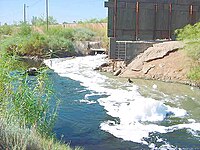
Photo from wikipedia
To control eutrophication and recover phosphate from wastewater, a calcium carbide slag and red mud composite material (CR-LDH) was prepared using industrial waste as raw material for phosphorus adsorption. The… Click to show full abstract
To control eutrophication and recover phosphate from wastewater, a calcium carbide slag and red mud composite material (CR-LDH) was prepared using industrial waste as raw material for phosphorus adsorption. The morphology and structure of synthesized CR-LDH were characterized by FT-IR, SEM, EDS, and XRD measurements. Bath adsorption test results showed that the optimal dosages of adsorbent and pH for phosphate were 5 g·L−1 and pH of 7, respectively. The experimental data could be well described by pseudo-second-order kinetic and Langmuir isotherm models, suggesting that the adsorption process of CR-LDH with respect to phosphate was a chemical and monolayer process. The theoretical maximum adsorption capacity obtained by Langmuir isotherm model was 16.06 mg·g−1 at 25 °C. The intra-particle diffusion model fitting results indicated that the adsorption of phosphate by CR-LDH was controlled by both liquid membrane diffusion and intra-particle diffusion. Phosphate was bound to CR-LDH via synergistic effect of physical adsorption, ion exchange, anion intercalation, and chemical precipitation as evidenced from a combination of microscopic analysis and adsorption mechanism study. The actual phosphate-containing wastewater investigation showed that CR-LDH not only exhibited good removal effect on phosphate, but also could greatly reduce turbidity, COD, and ammonia nitrogen, which was suitable for disposal of practical wastewater. The COD, turbidity, and NH4+-N could be reduced by 42.39%, 77.20%, and 20.71%, respectively. These results indicate that CR-LDH can be considered as potential adsorbent for the treatment of phosphate-containing wastewater, which will be helpful to achieve the goal of “treating waste with waste and turning waste into treasure”.
Journal Title: Environmental Science and Pollution Research
Year Published: 2021
Link to full text (if available)
Share on Social Media: Sign Up to like & get
recommendations!